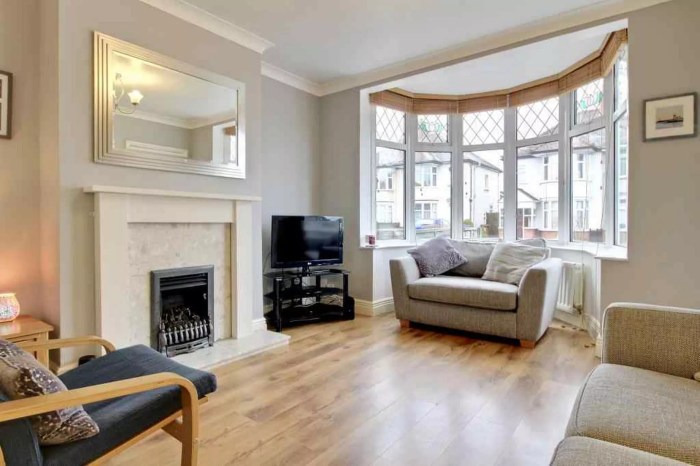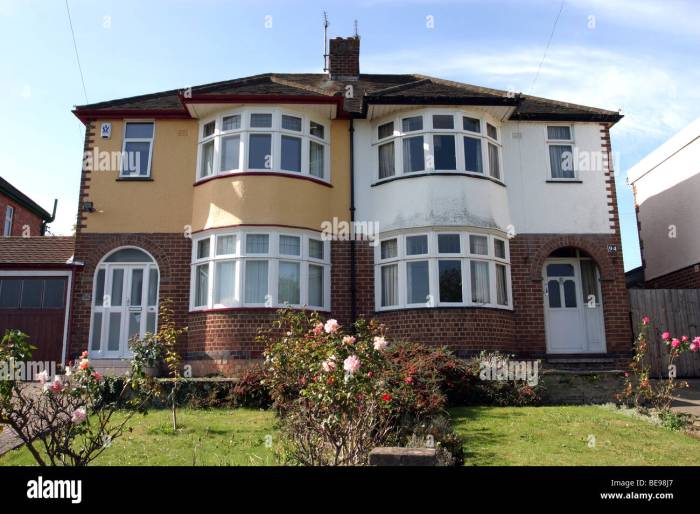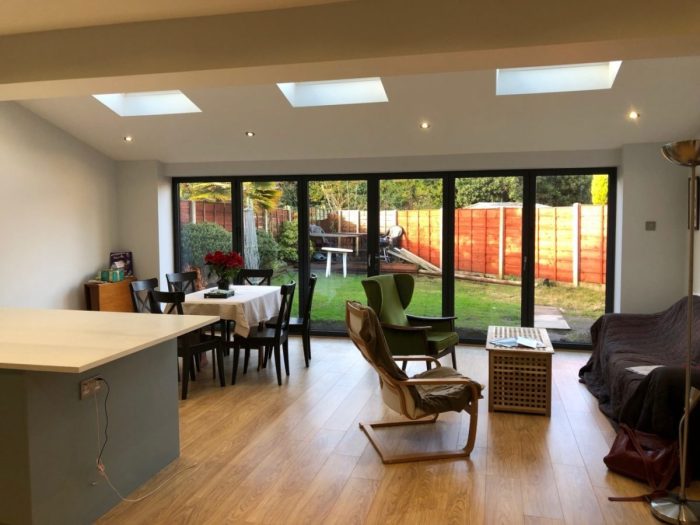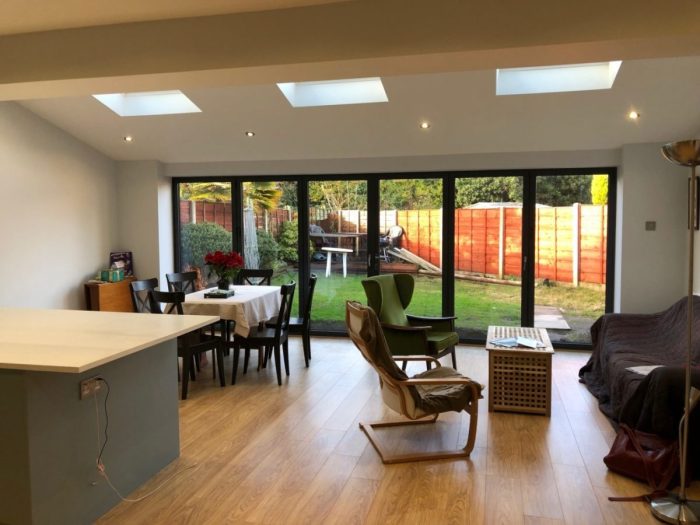1930s semi detached house interior design offers a captivating glimpse into a bygone era. This style, born from the social and economic shifts of the Great Depression, embraced a blend of functionality and elegance. The 1930s saw a move away from the ornate Victorian styles of the previous decades, with a focus on streamlined forms, simple lines, and a sense of practicality.
This period also saw the rise of Art Deco, a movement characterized by geometric patterns, bold colors, and luxurious materials, which had a significant impact on interior design.
From the choice of colors and materials to the furniture and accessories, every aspect of 1930s semi detached house interior design reflected the changing times. Homes were designed to be both stylish and comfortable, with an emphasis on creating welcoming and functional spaces for families.
This guide will explore the key features of 1930s semi detached house interior design, offering insights into the era’s distinctive style and its enduring appeal.
The Historical Context
The 1930s, a decade marked by both hardship and innovation, significantly shaped interior design trends. The Great Depression, a period of economic downturn, influenced home décor choices, forcing people to prioritize functionality and affordability. However, the era also witnessed a resurgence of traditional styles and the emergence of new design movements, reflecting the social and economic realities of the time.
The Impact of the Great Depression
The Great Depression, a global economic crisis that began in 1929, had a profound impact on interior design. With widespread unemployment and reduced incomes, people were forced to make do with what they had, prioritizing functionality over aesthetics. This led to a trend towards simpler and more practical home décor choices.
“The Depression brought about a shift in the American home, with a focus on practicality and affordability,” said a 2019 article in the Journal of Design History.
- Reupholstering and repurposing:People often reupholstered existing furniture instead of buying new pieces. This practice extended to other home décor elements, such as curtains and rugs.
- DIY projects:The Depression era saw a rise in DIY projects, as people learned to make their own furniture, curtains, and other decorative items. This trend not only saved money but also allowed for greater personalization of homes.
- Simple and functional designs:Furniture designs became simpler and more functional, with an emphasis on clean lines and sturdy construction.
- Use of natural materials:Due to economic constraints, natural materials such as wood and cotton became popular choices for furniture and fabrics.
Design Trends of the 1930s
The 1930s saw a blend of traditional and modern design trends. While the Depression encouraged practicality, there was also a desire for elegance and sophistication, particularly among those who could afford it.
- Traditional styles:Styles like Colonial Revival, Georgian Revival, and Tudor Revival continued to be popular, reflecting a desire for stability and continuity in a turbulent time.
- Art Deco:This glamorous and sophisticated style, characterized by geometric patterns, bold colors, and luxurious materials, remained popular among the wealthy.
- Modernism:The rise of modernism in architecture and design during the 1920s continued to influence interior design in the 1930s. Modernist homes featured clean lines, simple forms, and a focus on functionality.
- Streamline Moderne:This style, influenced by the sleek lines of airplanes and automobiles, emerged in the late 1930s. It featured curved forms, rounded edges, and a focus on streamlining.
Architectural Features of 1930s Semi-Detached Houses
The 1930s saw a shift in architectural styles, with semi-detached homes embracing a range of influences. These homes, designed to provide affordable housing for the growing middle class, incorporated elements of functionality and aesthetic appeal.
Common Architectural Elements
These homes often featured distinctive architectural elements that reflected the design trends of the era.
- Brick or stucco exteriors: These materials were durable and affordable, providing a clean and modern look.
- Gable roofs: Gable roofs were a common feature, often with decorative details such as dormers or overhanging eaves.
- Bay windows: Bay windows added visual interest and provided additional living space.
- Porches: Front porches were popular, offering a space for relaxation and socializing.
- Double-hung windows: These windows were efficient and provided ample natural light.
- Art Deco details: Some homes incorporated Art Deco elements, such as geometric patterns, stylized motifs, and bold colors.
Typical Layout and Floor Plan
The layout of 1930s semi-detached homes was designed to maximize space and functionality.
1930s semi-detached houses often featured a charming blend of traditional and modern design elements. The focus was on creating comfortable and functional spaces, often incorporating built-in features like bookshelves and cupboards. While the size of these homes might vary, you can find inspiration for designing a cozy and stylish space in a 1200 sq ft house interior design.
For instance, you can recreate the warmth of a 1930s home by incorporating natural materials like wood and stone, as well as adding vintage furniture and accessories.
- Entryway: The entryway typically led to a central hallway that connected the main living areas.
- Living room: The living room was often located at the front of the house, with a fireplace as a focal point.
- Dining room: The dining room was typically situated near the kitchen, often separated by a butler’s pantry.
- Kitchen: Kitchens were smaller than modern kitchens, but they were efficient and functional.
- Bedrooms: The bedrooms were located on the second floor, with one or two bathrooms.
- Basement: Many homes had a basement that was used for storage or laundry.
Popular Exterior Styles
The 1930s saw a revival of traditional architectural styles, often with a modern twist.
- Art Deco: Art Deco homes featured geometric patterns, stylized motifs, and bold colors. They often had flat roofs, symmetrical facades, and decorative details like sunbursts and zigzags.
- Tudor Revival: Tudor Revival homes were inspired by medieval English architecture. They featured half-timbered walls, steeply pitched roofs, and decorative details like gables and chimneys.
- Colonial Revival: Colonial Revival homes were inspired by 18th-century colonial architecture. They often had symmetrical facades, columns, and dormers. The use of white paint and green shutters was common.
Furniture Styles

The 1930s saw a shift in furniture design, moving away from the ornate and heavy styles of the Victorian era towards a more streamlined and functional aesthetic. This change was influenced by the rise of modernism, which emphasized simplicity, functionality, and the use of new materials.
Popular Furniture Styles
The most popular furniture styles of the 1930s included Art Deco, Bauhaus, and Streamline Moderne.
- Art Decowas characterized by geometric patterns, bold colors, and luxurious materials such as chrome, lacquer, and exotic woods. This style was often used in grand interiors, with pieces like the iconic “zigzag” chair by Marcel Breuer.
- Bauhaus, originating in Germany, emphasized functionality and simplicity. The Bauhaus style featured clean lines, minimal ornamentation, and the use of industrial materials like steel and glass. The Bauhaus armchair, designed by Marcel Breuer, is a prime example of this style.
- Streamline Moderne, a style influenced by the aerodynamic designs of airplanes and automobiles, featured smooth curves, rounded corners, and a sense of motion. This style was often used in furniture for living rooms and bedrooms, with pieces like the “waterfall” coffee table by Edward Wormley.
Iconic Furniture Pieces
The 1930s saw the creation of many iconic furniture pieces that are still popular today.
- The Chesterfield Sofa, with its deep buttoned back and rolled arms, is a classic example of Art Deco design. It remains a popular choice for living rooms and libraries, offering both comfort and elegance.
- The Bauhaus Armchair, designed by Marcel Breuer in 1928, is a prime example of the Bauhaus style. Its simple, functional design and use of tubular steel made it a revolutionary piece of furniture.
- The Eames Lounge Chair and Ottoman, designed by Charles and Ray Eames in 1956, is a classic example of mid-century modern design. This iconic chair, with its curved plywood shell and leather upholstery, offers exceptional comfort and style.
Functionality and Comfort in 1930s Furniture Design
Functionality and comfort were paramount in 1930s furniture design. The rise of modernism emphasized the importance of creating furniture that was not only aesthetically pleasing but also practical and comfortable for everyday use.
“The new furniture was not just for show, but for living in,”
wrote a design magazine in 1935. This focus on functionality led to the development of new materials and techniques, such as tubular steel, which allowed for lighter and more flexible furniture designs. The use of comfortable upholstery and ergonomic designs further enhanced the comfort and practicality of 1930s furniture.
Modernist Influences

The 1930s witnessed a significant shift in design aesthetics, with Modernism emerging as a dominant force. Modernist principles profoundly impacted interior design, bringing about a departure from the ornate and traditional styles of the past.
Modernist design championed functionality, simplicity, and clean lines, rejecting the elaborate ornamentation and superfluous details of earlier periods. The emphasis was on creating spaces that were practical, efficient, and visually uncluttered. Modernist interiors embraced a sense of openness and light, often featuring large windows, minimalist furniture, and a focus on natural materials.
The charm of a 1930s semi-detached house lies in its classic details, but modernizing its interior design can be a balancing act. If you’re considering a full renovation, it’s helpful to have an idea of the costs involved. You might be surprised by the range, especially for a larger space, like a 1500 sq ft house – check out this resource for a general idea.
Ultimately, the design choices for your 1930s home should reflect your personal style and budget, whether you’re aiming for a minimalist, contemporary look or a more traditional, cozy feel.
Art Deco and Modernist Design Principles
Art Deco and Modernism, while both influential during the 1930s, represented distinct design philosophies. Art Deco, with its emphasis on geometric patterns, luxurious materials, and bold colors, often featured lavish and opulent interiors. Modernism, in contrast, strived for simplicity and functionality, favoring clean lines, neutral colors, and practical materials.
While Art Deco celebrated ornamentation and grandeur, Modernism embraced a more restrained and functional approach. This difference in aesthetic reflected a broader cultural shift, with Modernism aligning with the rise of industrialization and the desire for efficiency and practicality.
- Emphasis on Functionality:Modernist design prioritized functionality over ornamentation. Furniture was designed with practicality in mind, featuring clean lines and simple forms that maximized space and ease of use. For instance, the iconic Barcelona chair, designed by Mies van der Rohe, embodies this principle with its sleek, minimalist form and comfortable seating.
- Simplicity and Clean Lines:Modernist interiors emphasized simplicity and clean lines, rejecting the elaborate ornamentation and decorative flourishes of earlier styles. This focus on simplicity resulted in spaces that were visually uncluttered and airy, creating a sense of openness and spaciousness.
- Use of Natural Materials:Modernist design favored natural materials such as wood, leather, and stone, which were valued for their durability, beauty, and authenticity. The use of these materials brought a sense of warmth and grounding to the interiors, while also reflecting the modernist emphasis on practicality and sustainability.
- Emphasis on Light and Space:Modernist interiors prioritized natural light and a sense of spaciousness. Large windows were often incorporated into the design to flood rooms with light, creating a sense of openness and airiness. This emphasis on light and space was a departure from the darker, more enclosed interiors of earlier periods.
Living Spaces
The living room, dining room, and kitchen are the heart of a 1930s semi-detached home, spaces that were designed for both functionality and style. The era’s emphasis on practicality and comfort is reflected in the layout and furnishings of these rooms, which were often compact yet thoughtfully arranged.
Living Room Design
The living room in a 1930s semi-detached house was typically a space for relaxation and entertaining guests. To achieve a period-appropriate look, incorporate these elements:* Furniture:
A comfortable sofa, often upholstered in a neutral fabric like velvet or linen.
Two or three armchairs, ideally with matching upholstery.
A coffee table, ideally with a glass or wooden top.
A bookcase or side table to hold lamps, books, and decorative items.
Lighting
1930s semi-detached houses often feature charming details like built-in bookshelves and fireplaces. While the overall space might be smaller, you can still achieve a cozy and functional design. If you’re looking for inspiration on maximizing space in a smaller home, check out 1200 square feet house interior design for ideas on creating a well-designed space.
These principles can be applied to any size home, even a 1930s semi-detached, helping you make the most of your space.
A large, central ceiling fixture, such as a chandelier or pendant light.
Table lamps, strategically placed to create pools of light.
Floor lamps, which provide additional illumination and can be moved to suit the occasion.
Accessories
Artwork, such as paintings, prints, or photographs, reflecting the era’s art deco and modernist influences.
Decorative objects, such as vases, sculptures, and clocks, in a range of materials like glass, ceramic, and metal.
Rugs, which add warmth and color to the space and can help to define different areas.
Dining Room Layout
The dining room was a crucial space for family meals and social gatherings in the 1930s. The layout was designed for practicality and style:* Table:
A large, rectangular or round table, made of wood or metal, with a sturdy base.
The table should be large enough to accommodate the entire family and guests.
Chairs
Matching chairs, preferably with upholstered seats and backs, for comfort.
The chairs should be sturdy and have a comfortable height.
Storage
A sideboard or buffet to store dishes, silverware, and linens.
A hutch or china cabinet for displaying fine china and glassware.
Kitchen Design
The 1930s kitchen was a functional space, with limited appliances and storage. However, homeowners could still create a stylish and inviting environment:* Cabinets:
Simple, well-designed cabinets, typically made of wood, to maximize storage space.
The cabinets should be painted in a light color to brighten the space.
Appliances
A stove, refrigerator, and sink were the primary appliances, often with a streamlined design.
Electric appliances were becoming more common but were still a luxury for many households.
Decor
Linoleum flooring was a popular choice for its durability and ease of cleaning.
Colorful curtains or blinds added a touch of personality.
Small decorative items, such as canisters, jars, and bowls, added a touch of style.
Bedrooms and Bathrooms

Bedrooms in 1930s semi-detached houses were typically designed for functionality and comfort, reflecting the values of the era. While space was often limited, careful planning ensured each bedroom served its purpose effectively.
Bedroom Design and Layout
The layout of a 1930s bedroom often featured a simple design with a focus on practicality. Bedrooms typically included a bed, a wardrobe, a dressing table, and a bedside table. The bed was usually a double bed or two single beds, placed against a wall to maximize floor space.
The wardrobe was often a built-in feature, providing ample storage space for clothes and other belongings. The dressing table was typically placed near a window, offering natural light for applying makeup or grooming. The bedside table, positioned next to the bed, held a lamp, books, or other personal items.
Bathroom Design and Features
Bathrooms in 1930s semi-detached houses were generally smaller and more basic than modern bathrooms. However, they were still designed with an emphasis on hygiene and practicality. The most common bathroom features included a bath, a washbasin, and a toilet. Baths were typically made of cast iron or porcelain, while washbasins were often made of porcelain or enamel.
Toilets were usually of the “low-level” type, with a cistern mounted above the bowl.
Bathrooms in 1930s houses were often decorated with patterned tiles, adding a touch of elegance and sophistication.
The use of tiles was common in 1930s bathrooms, particularly on the walls and floors. Tiles were often used to create decorative patterns or borders, adding visual interest and a sense of sophistication. Popular tile designs included geometric patterns, floral motifs, and Art Deco-inspired designs.
The use of pastel colors in bathroom tiles was also popular during this period, creating a sense of calm and serenity.
Privacy and Comfort in Bedrooms, 1930s semi detached house interior design
Privacy and comfort were essential elements in 1930s bedroom design. Bedrooms were considered private spaces where individuals could retreat from the hustle and bustle of daily life. The use of curtains or blinds on windows provided privacy and allowed for the control of light.
The use of soft furnishings, such as rugs, throws, and cushions, added to the comfort and warmth of the bedroom.
The emphasis on privacy and comfort in bedrooms was particularly important for families, as it allowed for a sense of personal space and relaxation within the shared home.
Final Conclusion: 1930s Semi Detached House Interior Design
Recreating the charm of a 1930s semi detached house interior requires a keen eye for detail and an appreciation for the era’s unique blend of practicality and elegance. By understanding the historical context, architectural features, and design principles of this period, you can create a home that reflects the spirit of the 1930s while incorporating modern comforts and conveniences.
Whether you’re restoring a vintage home or simply seeking inspiration for your own décor, exploring the world of 1930s semi detached house interior design is a journey into a captivating era of style and sophistication.
Frequently Asked Questions
What are some common materials used in 1930s semi detached house interior design?
Wood, metal, and fabric were popular materials used in 1930s homes. Wood was often used for furniture, floors, and trim, while metal was incorporated into lighting fixtures and accessories. Fabrics like velvet, linen, and silk were used for upholstery and draperies.
How can I create a 1930s color palette for my home?
A 1930s color palette typically features muted tones like cream, beige, and gray, often paired with accent colors like teal, burgundy, and mustard yellow. You can also incorporate metallic accents like gold or silver for a touch of glamour.
What are some iconic furniture pieces from the 1930s?
Some iconic furniture pieces from the 1930s include the Chesterfield sofa, the Bauhaus armchair, and the Marcel Breuer Cesca chair. These pieces are known for their clean lines, simple forms, and comfortable designs.
How can I incorporate Art Deco elements into my 1930s semi detached house interior design?
To incorporate Art Deco elements, consider using geometric patterns, bold colors, and luxurious materials. You can also find Art Deco-inspired furniture, lighting, and accessories to add a touch of glamour to your home.
